Something finally happened last year. Despite further critique by the naysayers, despite years of people having called peer to peer lending a ponzi scheme or comparing it to junk bonds, despite some undeservedly declaring it a financial bubble, last year we finally turned a corner in the story of online lending.
Peer to peer lending finally became accepted. In 2013, it became cool.
This is not to say it is yet popular. Far from it. Most people I encounter are still unaware that peer to peer lending even exists. However, in 2013 the national investment community finally took a long hard look at platforms like Lending Club and Prosper. After years of veritable positive press and answered critics, the financial world finally opened up their wallets and took a seat at their table.
Peer to Peer Lending in 2013: Three Seismic Shifts
The national shift in favor of p2p lending was evidenced by three major co-occurrences.
#1. Wealthy Financial Institutions Entered the Arena
Most notably, 2013 saw the entry of some of the largest financial institutions in the world wanting a piece of p2p action. Their investment came in two different ways. First, major backers bought equity in the platforms themselves, like BlackRock did in September when they joined Sequoia Capital in backing Prosper as a company (read NYTimes). For those who might be unaware, BlackRock is the largest manager of money worldwide (Wikipedia: $4T in managed assets. Yep, T for trillion).
Second, we had financial institutions become the main source of funding for individual loans. For years, individual retail investors like myself were the way peer to peer loans got funded; not anymore. Marc Prosser said this best when he noted how 2013 marked the evolution of ‘P2P Loans into Consumer Loans‘. While most sites (including this one) continue to refer to this asset class as peer to peer lending, Marc’s point was a good one: the game has fundamentally changed. Lending Club & Prosper issued a combined $300 million in loans in December 2013. 43% of all the loans issued ($130m) came from loans purchased whole, that is, through a program that caters to the deepest pocketed investors. This, combined with their investing on the main (fractional) loan pool, made institutions the largest presence on the platforms today, a situation that should become more and more dramatic with each year that goes by.
#2. Google’s Investment in Lending Club in May
Secondly, we had Google purchase a share of Lending Club as a company (NY Times), legitimizing peer to peer lending even further. Their investment was for $125 million, five times the size of BlackRock’s in Prosper. This 7% purchase of the company valued Lending Club at a staggering $1.55 billion. However, more notable than the valuation was the action of the investment. You see, Google is a company that is nearly synonymous with the internet itself. As operators of search and YouTube, Google has a distinct ability to see where the world is heading, and a $125 million investment in Lending Club was not just a validation of the company, but additionally a gesture of eagerness towards peer to peer lending as a whole.
#3. Lending Club & Prosper Crossed $4 Billion in Issued Loans
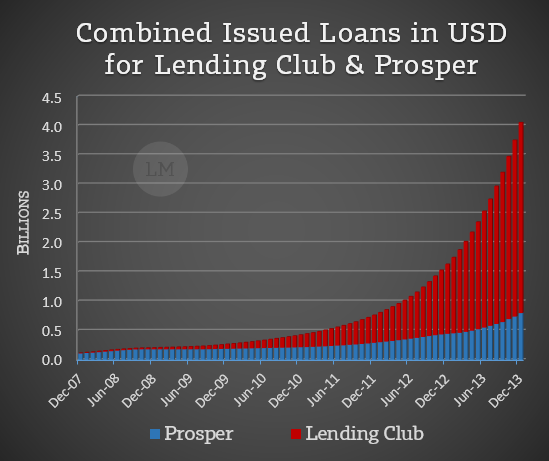
It is good to highlight why all this outside big-dollar interest happened at all, specifically in how 2013 was a year of phenomenal growth for the platforms themselves. Compared to 2012, Lending Club and Prosper experienced a combined growth of 177%, nearly tripling their loan volume in twelve months, pushing them past the $4 billion dollar mark in total issued loans.
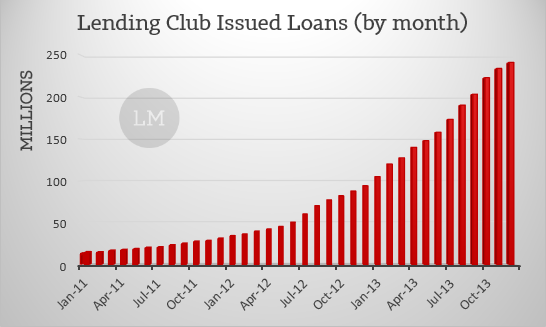
Lending Club: Looking at each platform, it is good to note that Lending Club finally became cash-flow positive in late 2012, so 2013 saw 12 months of reaped profits after years of burning through investor cash. The last twelve months saw this company become one of the largest issuers of loans nationwide (issuing $2 billion in 2013 alone), a far cry from its 2007 start as a humble Facebook app.
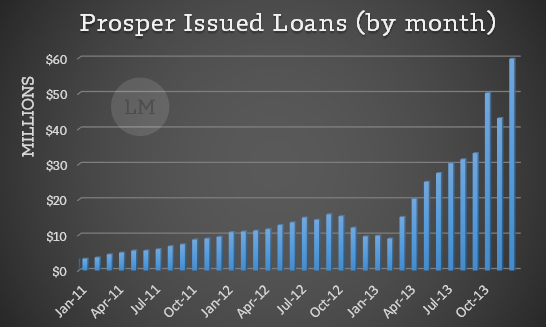
Prosper: Early 2013 saw Prosper reborn under a fresh management team. This new leadership (Stephan & Aaron Vermut and Ron Suber) did a remarkable job at pulling Prosper out of its late-2012 financial tail spin. Not only did they successfully settle the company’s notorious and burdensome class action suit, but more notably the Vermuts and Suber completely restructured Prosper around prime borrowers under a new FICO-based credit model, a solid foundational decision that should help Prosper grow in public trust and compete with Lending Club for the national spotlight in 2014.
5 Possibilities for Peer to Peer Lending in 2014
All this to say, 2014 looks to be the most exciting year in peer to peer lending’s history, full stop. Here is what’s going to happen:
#1. Lending Club Will Have Its IPO (Triggering the Blue Sky Exemption)
As previously covered by major news sites (including Forbes: Lending Club with IPO in Sight), 2014 looks to be the year when Lending Club has an initial public offering, which means it becomes a public company traded on the stock market. This holds promise to be a huge day for everybody at Lending Club. Considering how the company has a current value of $2.3 billion (placing alongside tech companies like Twitter and Pinterest) going public could rocket this value even higher, establishing Lending Club as one of the most valuable tech companies in the world.
A side-result of Lending Club’s coming IPO is how it will institute a so-called blue sky exemption for investors nationwide. Currently, Lending Club has had to approach each state’s financial regulators individually in order to allow investors of those states to gain entry on the platform. This is why Lending Club does not currently allow lending in 24 states (including populated states like Texas and Ohio). However, the coming IPO would trigger an exemption that would allow investors in every state access to Lending Club (despite their regulator’s naysaying), which could result in a lot of people becoming new investors at Lending Club.
#2. Prosper Will Become Cash-flow Positive
In late 2012, Prosper’s future was in doubt (see the dip in monthly originations above). Yet, just twelve months later, Prosper is poised to stop burning venture cash and hit profitability in 2014 (congrats guys!). This looks to be a remarkable turnaround for the peer to peer lending underdog, and a great setup for them to go toe-to-toe against Lending Club in 2014.

Prosper CEO Aaron Vermut, Executive Chairman Stephan Vermut, President Ron Suber
Though I rank this second in significance to Lending Club’s IPO, it is a very close second. Competition between two profitable peer to peer lending platforms is a critical necessity for an excellent overall experience for everyone involved, both borrowers and lenders.
#3. P2P Platforms Could Issue $6-7 Billion in Loans in the Next 12 Months
In the past year, the platforms issued a staggering $2.4 billion in loans (see Lend Academy), a growth of 177% in a single year. If current trajectories continue, I calculate that the coming year may see Lending Club issuing $5.5 billion in loans, with Prosper issuing a wonderful additional $1.2 billion on their own, totaling a possible $6.7 billion in issued peer to peer loans in 2014.
Honestly, I don’t know the full implications of this much issuance, other than how it may help continue to solidify peer to peer lending as a legitimate investment in the eyes of the nation.
#4. Big Changes Will Arrive for Retail Investors
One thing that I feel has not been given enough exposure is how peer to peer lending may change for the average retail investor in the coming year. I personally feel 2014 will be a huge year for retail investors in regard to the creation of (1) new data tools and (2) a wider use of API.
Exciting New Data Tools: While we have certainly been blessed by sites like LendStats and NickelSteamroller over the years, I think this year will see the launch of more savvy and exciting analytics for retail investors. While tools like NickelSteamroller’s Lending Club Return Forecaster have been crucial in our success as lenders, I think additional tools are going to emerge that really take this whole investment to another level. For example, Lending Robot does amazing stuff with Lending Club’s historical data.
More Widespread Investing via API: It is no secret that the best notes are not being bought over the LendingClub or Prosper websites, but are being snapped up by servers over API (read more in the final sections of this article). As Lending Club and Prosper continue to allow easy access to API for those who want it, I think we will see this medium grow more numerous and competitive with each passing month. I have heard rumors that some API servers have relocated to the same cities as Lending Club & Prosper’s servers to decrease purchase latency, and personally speaking, my own API investments of low-grade notes at Prosper have become more difficult to execute in the past few months, evidence that more and more investors are going this route.
#5. Other Various Possibilities: New Media, Taxes, and the SEC vs. P2PAutoInvest5000.com
Finally, I think 2014 may see a few additional items of interest, specifically (1) the launch of additional media sources, (2) the refining of tax strategies, and (3) new regulatory action against unaccredited tool sites. Regarding new media outlets, I would not be surprised if financial sites like Forbes or the Wall Street Journal create new peer to peer lending-specific channels. Furthermore, we may see the launch of big-dollar versions of sites like LendingMemo or Lend Academy that focus on lender education and news.
I think 2014 could be the first year where Lending Club and Prosper get their tax procedure figured out. Each April has meant a coming headache for the retail investing community, and this April looks no different. Is it possible that the platforms may finally get things simplified by the end of the year?
Regarding regulation of tool sites, I have been a bit concerned by the number of peer to peer lending sites that are charging fees for the auto-bidding of notes, yet are not registered as financial advisers with the SEC (Wikipedia). I think the coming year may see the first cease and desist letter or lawsuit being issued against one of these sites for the first time. This would, of course, send shock waves throughout the retail investing community, causing people to rethink their investment approach for the coming year.
Conclusion: 2014 is Gonna Be Huge
What a significant year 2014 looks to be! Billions of dollars in new loans, new tool sites and articles, exciting new features by the platforms, and more solid coverage by national media. Perhaps most importantly, 2014 looks to be another year when thousands of borrowers get access to low-interest loans and thousands of investors get access to solid stable returns. As the internet continues to remove the corrupt and wasteful banking institutions, I am eager to see the sleek and savvy reality of peer to peer lending take its place.
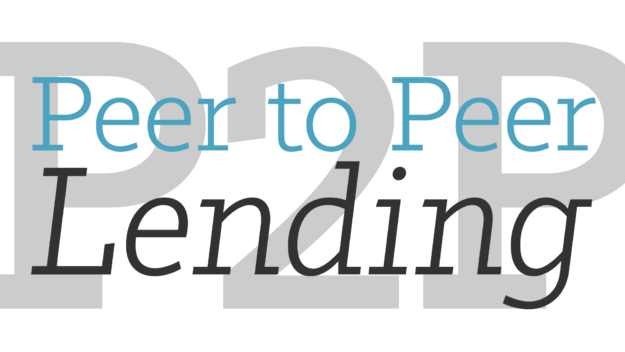
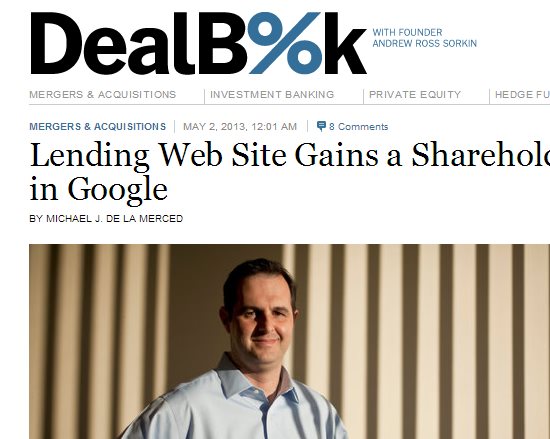
Great article Simon. I think many of your predictions here will come true. One of the key points you make, that I should have also emphasized, is that by the end of this year serious retail investors will be able to invest in an automated way on these platforms and for the first time be truly able to compete with the large investors.
One clarification: Google did not invest $125 million in Lending Club in May 2013. We don’t know how much they invested, we just know the total investment in that transaction was $125M. But Foundation Capital also made a significant investment alongside Google.
Thanks Peter. And thanks for the Google clarification. I was unaware of that.
Peter, what are your thoughts on the staying power of some of these third party tools? Do you think LendingClub will introduce automation beyond prime which will lower the demand for third party products?
What I would like to see with all the third party tools is for them to invest in some solid legal advice. As Simon suggests in the article many of them are operating illegally and are in danger of being shut down anyway. So, I think we will see those that are serious go through the necessary legal hoops to continue to operate and those that are not will switch to a free model for their software.
As for Lending Club, they have been talking about automation for years now but these days they have a problem. If they introduce automation now for all retail investors there will likely be no loans left for those people who want to invest manually. This is why they are pushing PRIME – it gives automation but where they are in control of it, not the investor.
Interesting bit about the potential of a cease and desist letter to a third party tool site. From my perspective, 2013 really did feel like the wild wild west when it came to third party tools. I really think 2014 will bring maturity (and stability) to some of these and perhaps the demise of others, but we had to start somewhere. Like you mentioned, there are so many people who still don’t know about peer to peer lending and it will only continue to grow.
Hi Simon
You are becoming a great source of knowledge and education for us in the UK, we are a new-start (eMoneyUnion) and are very much taking great inspiration from your blogs and experiences with Prosper and Lending Club. 2014 is set to be huge for the UK personal loan platforms, ourselves as the fast growth baby of the bunch next to Zopa and Ratesetter.
As you may or may not know, we are in a transitional regulatory regime for Peer to Peer in the UK. The UK Government is currently in consultation to allow Private Lenders to invest via an annual limit (ISA Allowance) of £11,520 into Peer to Peer loans as a new asset class in a tax free manner. We are all very excited about this and will be a game changer here.
How long do think it will be before institutional and retail lenders can not only choose borrower risk grades but also country of origination?
We get people from all over the world wanting to be lenders, as a I’m sure Lending Club and Prosper do to.
Hi Lee. Thanks for the great comment. Your question about these platforms opening up to international investors is a good one, but a bit outside my expertise, as well as one that does not seem on the radar for American lending platforms for the time being. First of all, the SEC has classified these as securities, so there are standards for the investors in securities that have to be enforced. Basically, I’m unsure how international investors could be regulated by the SEC. Secondly, the p2p lending economy is lacking borrowers, not investors, so there really is little incentive for these platforms to seek additional channels. That said, sometime in the future the balance could again shift in favor of needing more investors, and I’m sure the platforms would look into international channels if they seem doable.
Simon, Thanks for the great article. Just the thought of what you said in regards to the third party tools has already sent “shock waves” through my investing strategy. I hope you are wrong in this regard. I am not at all computer savvy, so I would hate the thought of figuring out how to set up an API for myself. I worry what would happen if I lost my automation tool through my third party site. I have been very pleased with the portfolio I am acquiring using this method, and I know there is no way I could match it on my own. Again, I hope you are wrong… with this part at least.
Hi GA. I hope I’m wrong as well, but I can promise you the landscape is bound to change. Situations like this are kind of why the SEC was established in the first place.
Great article and predictions, Simon. I hope some of them will come true.
What is your opinion on all new p2p lending platforms shunning retail investors in favor of institutions on lender side? Do you see retail investors continuing to be an important direct source of lending money?
Any thoughts on when Lending Club and Prosper will start to redirect retail investors through one of their lending institutions instead of letting retail investors lend directly?
Hi Anil. Good to hear from you; I owe you a coffee. To be honest, I don’t think retail is getting shunned. Sure, the platforms could both do something more to help retail non-API get better access to low-grade loans (especially on Prosper), but overall I think they continue to be valued and serviced quite well by these companies. As for redirection, I don’t really see this happening, but you might have a better grasp on that than me. Email me and let’s hang out.
Hi Simon,
Love your site, think you are doing an amazing job. It’s great for us to learn all of the things that you could keep to yourself!
Anyway, I wanted to ask your opinion of these 3rd party tools as businesses. Do you think that they will continue to operate independently of the platforms that they serve (or leech depending on your view) or do you think that the platforms will conspire to 1. Acquire or 2. Litigate against them?
Thus far it seems that the 3rd party tools are very, very useful to the skilled investor, and if I were LC or Prosper I’d have my eye on them. Interested to hear your thoughts!
Thank you,
Hi Zach. Thank you for the kind words. I don’t want to put words into Lending Club or Prosper’s mouths, but I forsee trouble coming more from federal/state regulators than from the platforms. That said, a platform like Lending Club might have a great deal of interest in shutting down a large unsecure unregulated 3rd party tool. What if a tool, run by a guy out of his garage in Boise, contained credentials of thousands of Lending Club investors. Would Lending Club be interested in avoiding a headline like “Hackers Steal Thousands of Lending Club Logins. Thousands of Loans Sold on Foliofn for 1 Cent”? I think so.
I don’t think they are too interested in acquiring them, though its quite likely they are looking through them for ideas on how to expand their own operations. Moreso, I think they may keep their hands off for now, and welcome regulators shutting sites down that they deem a threat.
P2P loans are federally classified as securities. Third party tools need to start internalizing this reality.
Solid points Simon, I see what you are saying in the way that they are operating. As exposure to the amount of money flowing through these platforms grows, security will be a huge issue.
Simon,
Great post as usual – I’ve been a long time lurker but your site and others inspired me to start writing about my experience as well.
I’m pretty excited about 2014 as well, though I think the Lending Club IPO should have investors pretty concerned from the point of view of putting new money to work. If the IPO potentially opens up investment to the currently blocked community, there are millions more new investors that could come on the platform, and selfish as it may be, I’m not sure that’s a good thing for the current investor community.
In 2013 it really seemed like the word got out, and we all know how hard it got to find loans last year without using some kind of service, none of which look all that professional or trustworthy. No offense to the proprietors of those tools, but as you say, it’s an unregulated space and most of the tools out there are being run out of a garage, so the potential for fraud is high I would say.
I wonder at what point Lending Club will have to start to consider a reduction in rates if investor supply outstrips borrower demand. I wish there as more information around this topic specifically from Lending Club – perhaps they will call it out as a risk and quantify in some way in an S-1?